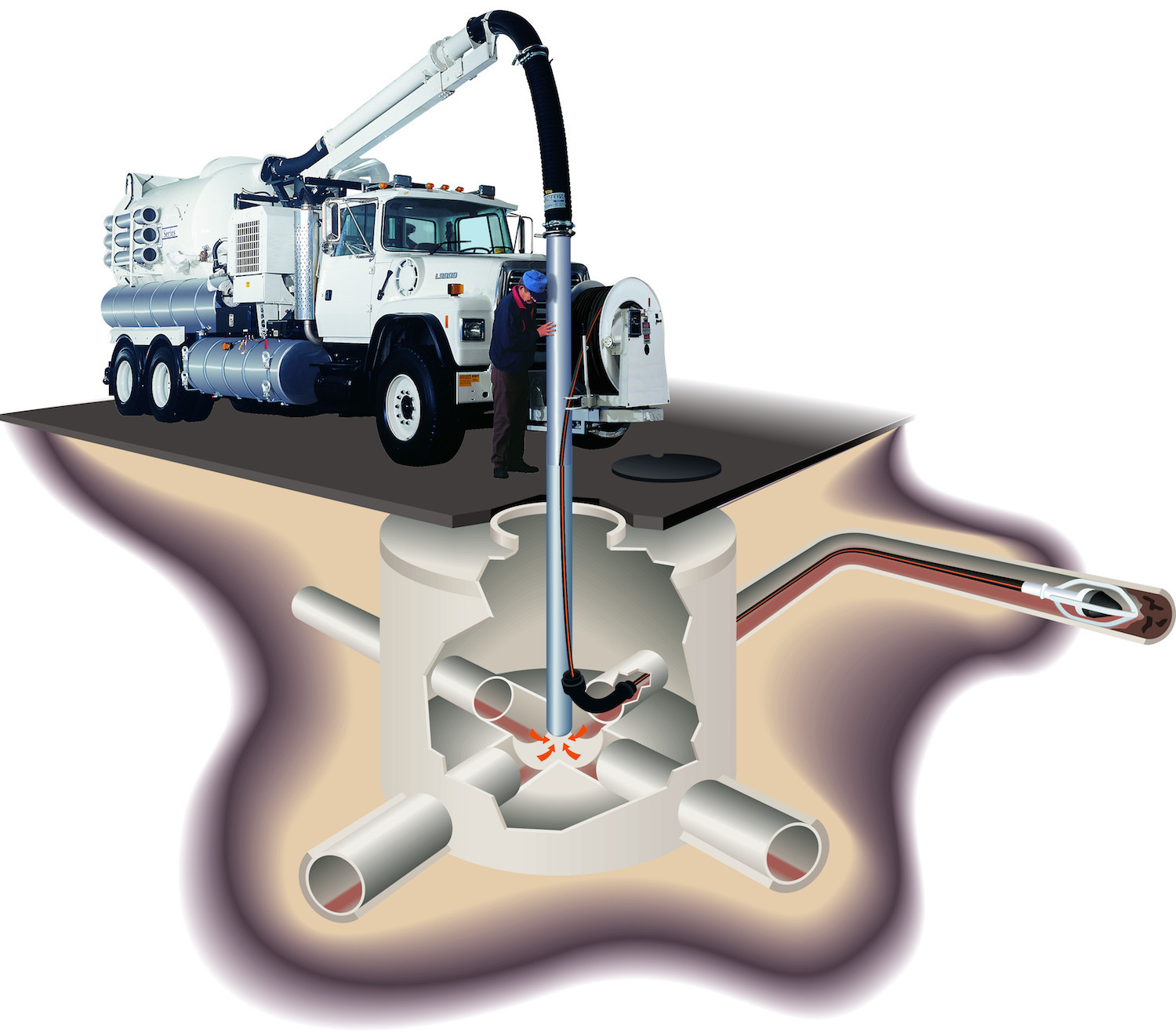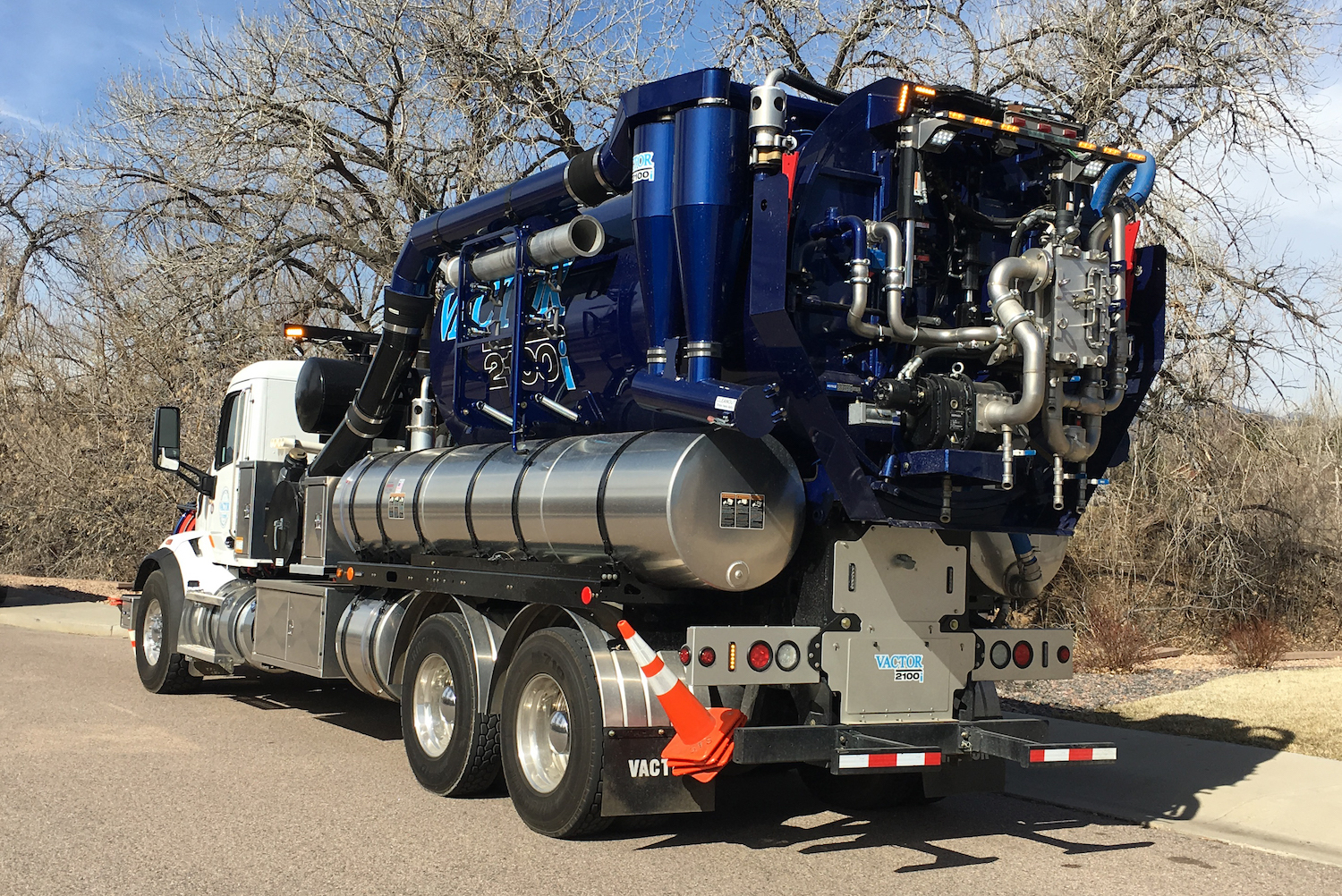Interested in Trucks?
Get Trucks articles, news and videos right in your inbox! Sign up now.
Trucks + Get AlertsThe concept of water recycling for sewer cleaning applications has been around since the early 1980s. The interest and demand for water recycling has been driven in recent years by new technology and product innovation, increased awareness for water conservation, and municipalities having to do more with less.
Contractors, municipalities and utility companies can all realize great benefits using a combination sewer cleaner equipped with a water recycling system. These customers are all facing many of the same challenges: reducing the impact on the environment, conserving resources, advancing productivity of the line-cleaning process, and cleaning more sewer line with the resources they have. A water recycling system provides a substantial step in the right direction.
How typical combination sewer cleaning works
The bullet points in bold are nonproductive steps that don’t add any value to the overall sewer cleaning process.
- Drive the truck to the water source
- Fill the sewer cleaner with clean water
- Drive the truck to the cleaning site
- Set up traffic control around the site
- Set up the cleaning site
- Propel the nozzle upstream from the manhole with a high-pressure water jet
- Withdraw nozzle using the powered reel to flush material toward the manhole
- Vacuum material and water from the manhole into the debris body
- Tear down the cleaning site
- Decant excess liquids back into the sewer system
- Repeat the process
Vactor employees regularly hear stories about poor access to water due to limitations to available water hydrants or having to return to the base of operations — which could be on the opposite side of town — for more water. Then, when the truck finally arrives at the job site, additional time is spent setting up traffic control again.
The cleaning process is generally performed by propelling the nozzle out as quickly as possible to conserve water. However, nozzles have limited material carrying capacity, so the nozzle is retracted much slower. There is also the potential for a buildup of material to get stuck behind the nozzle.
As a result, some level of step cleaning is common, which uses more water than planned.

Combination sewer cleaners combine high-pressure water jetting and a high-flow vacuum source to scour pipes clean, then vacuum up the material causing blockages to restore and maintain normal sewer flow.
Step cleaning
In the real world, you can’t see what’s going on inside the pipe. You can’t tell how clean or dirty the sewer line really is, and the water isn’t completely effective at bringing the material back to the manhole.
Most of the time, the step cleaning process is used regardless of the amount of material in the line, just to ensure it is clean.
This process uses a significant amount of water, and the water capacity on a typical sewer cleaner is limited. If operators don’t want to run out of water, they may consider skipping this step or not cleaning it quite as well as they would if they had an unlimited water supply.
Time and lost productivity
Having to stop to refill water tanks requires time and results in lost productivity. If you have a hydrant a block or more away from the manhole you’re currently cleaning, you need to pack up the job site, fill the truck with water, and return to the manhole, which can take 20 minutes or longer under the most ideal circumstances. It’s more common for this process to take upwards of 40 minutes.
Sewer cleaning variables
Cleaning sewers involves a number of variables, including sewer line size and length, volume of material encountered, and flow rates required to carry material to the manhole. On average, it takes 2 gallons of water to clean 1 foot of pipe. A typical sewer truck carries a maximum of 1,500 gallons of water, so the available onboard water supply can only clean about 750 feet of sewer line before the water tank needs to be refilled.
It’s rare for the onboard water to run out at the exact time the cleaning of that line is finished. What typically happens is that the operator reacts to the low water warning and increases the rate at which they are returning the nozzle in order to hurry up and “finish” the line, more than likely leaving material behind. The other likely scenario is that the operator still has water on board at the end of the line, but they partially fill the water tanks to avoid running out of water at the next line. Again, more inefficiencies.
Growing demand for water recycling
How do you remove those sewer cleaning inefficiencies? By recycling the sewer water.
There are number of factors involved in the growing demand for water recycling, including:
- Greater awareness of the value of potable water
- Greater awareness of the costs to process potable water and wastewater
- Greater awareness of sewer overflows and fines assessed
- More communities are having to clean more lines more frequently, despite limited resources
Material separation
So, how does recycling work on these machines? There are three ways to separate the solids from the liquids and none of them are completely effective:
- Settling
- Classification screens (filters)
- Centrifugal separation
Settling is the least complicated method of material separation. This involves moving the material to a tank or container that allows the heavier solids to settle out from the liquids. Sometimes baffles are used to aid in this process.
Classifications screens or filters can vary by the size of the solids they separate from the liquids. Things like grease and rags will often cover up the holes and prevent liquids from passing through to the water pump.
Centrifugal separation works by accelerating the heavier material to the outside, which causes it to gather at the bottom of a conical container. The clean water exits at the top. The effectiveness of centrifugal separation is dependent upon many variables, most of which cannot be controlled while operating in a sewer. These include:
- Density of the solids
- Concentration of the solids relative to the volume of water
- Type and shapes of the solids
- Grease attached to the solids
- Water velocity (a function of the flow rate provided to the filter)
System considerations
The following factors should be addressed when considering the effectiveness of a water recycling system for sewer cleaning:
- Continuous process vs. batch (don’t interrupt the cleaning process)
- Filtration level – water quality matters to your truck’s components
- Target the smallest particle size
- Understand what can get through the system
- Lowest water velocities in system – valves, pipes, pumps, hoses
- System limitations
- Materials of construction
- Capacity for standard use
- Maintenance — access and frequency
The purpose of recycling the water is to save water, clean more lines and work safer. The purpose of the filter system is to protect the pumping system on the truck. While you could theoretically add pond water to your water tanks, the pump wouldn’t last very long without a filter system.
It’s important to understand your pump speed and water velocities related to that pump. Abrasives in a high-velocity water stream can cut through steel.

A combination sewer cleaner equipped with a water recycling system offers a number of benefits, including increased productivity and safety for work crews, reduced downtime, and cleaner lines.
Recycling challenges
Challenges related to water recycling include:
- Too much solid material (no liquid to recycle)
- Grease (impact on filtration)
- Rags (impact on filtration)
- Vacuum required to filter material
- Payload (weight and movement of liquid)
- Fittings
- Nozzle quality
When cleaning combination storm/sewer lines, you encounter a significant amount of solid material. Too much grease or too many rags will destroy any filter.
Getting water requires vacuuming it from the manhole. In general, operators not using a water recycling system will actually skip manholes because the setup process just takes too long.
Most operators are driving from manhole to manhole with a combination of water and debris in the debris body to continue the recycling process, so it’s important to be mindful of payload. The end result after a day’s – or multiple days’ – worth of work is a denser load from constantly removing the liquid.
When it comes to fittings, everything needs to be tight. Any leak path in a fitting will quickly cause threads to erode.
As with fittings, a small amount of debris can burn through a nozzle. Good nozzles with good inserts are required to keep the unit running. Only use nozzles specifically designed for water recycling systems.
Benefits of water recycling
If an average of 10,000 gallons of water per day can be saved on a single sewer truck in a typical work year, that equates to 2.6 million gallons of water saved each year, for a single truck.
Saving 10,000 gallons per shift is just an average all of the examples Vactor has collected over years of product development, field testing, product demonstrations, and customer feedback. This will vary depending on the application, the cleaning process employed, the goals of the operators, etc.
A combination sewer cleaner equipped with a water recycling system offers a number of benefits, including:
- Increased productivity
- More efficient revenue stream
- Reduced downtime
- Additional week of revenue per month
- Cleaner lines
- More lines cleaned
- Increased safety for work crews
- Increased return on investment
Value of water
Eliminating the use of potable water is a huge gain for the environment. Many communities need to conserve water and are restricting where trucks can be refilled. This further reduces the cleaning productivity, because refilling is required multiple times a day.
With a water recycling system, the use of potable water for line cleaning can be eliminated. A water recycling system not only reduces the cost of using freshwater, it also reduces the time required to make multiple trips to a hydrant or water-filling facility to refill the truck.
Reduced overflows
Communities are expected to maintain their sewer systems and prevent overflows to protect people and the environment, and to avoid the potential for financial penalties and health risks associated with overflows. In addition, many communities are working with reduced budgets for operating expenses.
With the ability to recycle the water used for sewer cleaning, these communities can clean more lines with existing resources and reduce operating costs.
Water recycling systems help sewer cleaning operations save hundreds of thousands of gallons of fresh, clean water, improve operating efficiencies, reduce costs and promote sustainability.
In general, the return on investment of a sewer cleaner equipped with a water recycling system — the potential to double line-cleaning productivity while conserving thousands of gallons of clean water each day — is very attractive when compared to existing alternatives.
For more information on the Vactor water recycling system available as an option on the Vactor 2100i combination sewer cleaner, or to schedule a demonstration, please visit www.vactor.com or see your local Vactor dealer.






